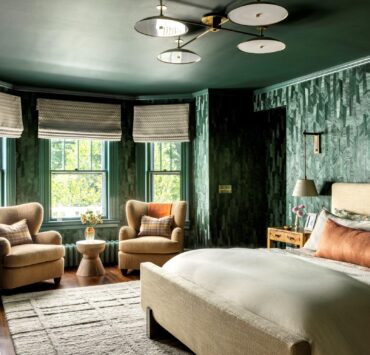Lighting design is increasingly intertwined with smart home technology, and Kalco Lighting and is navigating this carefully. Their award winning designer, Takayuki Ishii, is focused on blending advanced lighting technology with thoughtful design to meet the shifting demands of both aesthetics and functionality in modern homes.
In conversation with Ishii, he explains how Kalco is tackling technical challenges like color-changing LEDs, UV-resistant finishes, and thermal management for crystal fixtures. He discusses the steps taken to ensure that Kalco’s products are not only beautiful but also integrate seamlessly into the smart home ecosystem.

Looking ahead to 2025, Ishii also discusses Kalco’s approach to system compatibility, sustainable practices, and how lighting can enhance both residential and commercial environments.
Technical innovation & development
DNN: What were the critical technical challenges in developing your fluorocarbon finish to achieve both UV resistance and crystal compatibility while maintaining aesthetic standards?
TI: To achieve UV-resistance and crystal compatibility while maintaining our high aesthetic standards, we leveraged the inherent UV-resistant properties of fluorocarbons, available in fine and coarse powders.
Through extensive testing, we determined the optimal ratio of fine to coarse powders. This balance preserves a matte finish while providing superior resistance to scratches and fingerprints, providing a flawless, premium finish on the decorative fixtures.

DNN: How did you solve the thermal management challenges in your crystal fixtures to accommodate the heat dispersion needs of color-changing LED modules without compromising design integrity?
TI: Designing fixtures crafted with Firenze Crystal and advanced color-changing LED modules requires careful thermal management without compromising modern style. Hidden technology plays a pivotal role in maintaining the natural beauty of our Firenze Crystal designs.
From the earliest conceptual stages, our designers consider the size and placement of LED heatsinks, lenses, switches, and drivers. Close collaboration with our factory ensures that critical design elements are protected and seamlessly integrated into the final product.
DNN: Tell me about the driver architecture that enables precise CCT control while maintaining flicker-free dimming across your entire dimming range.
TI: Ensuring precise Correlated Color Temperature control and flicker-free dimming across the entire range requires seamless compatibility between CCT LEDs, CCT switches, LED drivers, and wall dimmer switches.
While Kalco Lighting does not manufacture wall dimmer switches, we provide detailed guidance in our catalogs and installation diagrams to ensure proper integration.
Each fixture undergoes rigorous testing in our factory, passing stringent QC standards. Additionally, we support electricians during installation, addressing issues such as low voltage arcing or insufficient grounding that could lead to flickering or LED shutoffs.
All Kalco Lighting and Allegri Crystal fixtures come with the customization option to integrate fixtures with the CCT technology, allowing customers to select the color temperature, from cool to warm hues, they want their fixture to feature.

Manufacturing & quality control
DNN: What specialized quality control measures have you implemented for testing color consistency and performance degradation in CCT-enabled fixtures?
TI: We test every fixture against a control sample using precision light meters across all color settings. Additionally, fixtures that pass individual quality checks are lit at the same time in batch testing before final packing to confirm they have a uniform color performance.
DNN: How are you managing component sourcing and binning to ensure consistent performance across your smart-enabled collections, particularly with current supply chain volatility?
TI: Our suppliers maintain strict diode binning controls, using only specific combinations to produce our parts. To ensure consistency, we also perform random testing against control samples provided by LED manufacturers.
Lighting system integration & specification
DNN: How are you addressing compatibility between your control systems and existing architectural control protocols (DMX, DALI, etc.) in major commercial projects?
TI: We begin by identifying the type of dimming required, including the manufacturer and system specifications, during initial conversations with our customers. For new buildings or renovations, we adapt to project needs, even when information is limited.
To address such challenges, we include detailed specification notes in our CAD submittals to ensure parts compatibility. Additionally, we maintain close communication with our parts suppliers’ engineers to confirm compatibility with any dimming system used in the U.S.
DNN: What tools are you providing specifiers to validate color performance across different CCT settings during the design phase, particularly for BIM integration?
TI: We’ve developed two types of small, portable light boxes: one with a frosted diffuser for Kalco Lighting and another with a crystal diffuser for Allegri by Kalco. These tools allow customers to explore and visualize the actual CCT colors we offer.
DNN: How does your current driver architecture anticipate upcoming wireless protocols and IoT standards?
TI: While most of our current drivers are not wireless or IoT-compatible, we experimented with wireless RGBW color-changing technology in collections like the Lina RGBW Collection.
Recognizing that many luxury smart homes already have centralized lighting systems, we aim to balance innovation with simplicity, avoiding excessive reliance on standalone control apps. Wireless and IoT technologies are key considerations for future product development, ensuring our offerings align with emerging standards.
Market strategy & application
DNN: Beyond regional preferences, what project-type patterns are you seeing in CCT specification across healthcare, residential, and hospitality sectors?
TI: Customers often buy light fixtures from several different lighting manufacturers for different spaces in their property. This creates a challenge due to slight variations in LED color temperature. Offering adjustable CCT options ensures our fixtures harmonize with others, achieving consistent lighting aesthetics across shared spaces.
Additionally, Kalco observes that homeowners have different color temperature preferences by region. For example, customers in South Florida often gravitate toward cooler tones, in the 4000K range, while homeowners in the Midwest select warmer, cozier tones in the 2700K range.

DNN: How are you supporting architects in specifying these technologies within WELL Building Standard and LEED certification requirements?
TI: Human health and environmental impact are integral to our design philosophy. All our LED fixtures are fully dimmable and compatible with most lighting control systems. Additionally, we provide IES files of our fixtures when a client requests them.
LEED Certification – At Kalco, a growing design style and trend is crafting collections with materials derived from nature. Several of our designs are made with responsibly sourced materials, including Capiz shell and Acacia wood. As a manufacturer, Kalco is also involved in other sustainable building practices including replanting the Acacia trees, native to the Philippines, after harvesting the wood.
WELL Building Standard – Kalco Lighting not only designs luxury fixtures but also develops lighting for human health and wellness. The Lina desk lamp was recently tested by a leading oversight agency for its circadian effectiveness and scored half of the necessary score, making it a beneficial supplement lighting piece to aid in producing a circadian-effective environment. The Lina desk lamp proves that circadian-effective lighting can not only be beneficial to the user’s health but beautiful as well.
DNN: How are advancements in LED phosphor technology and next-generation drivers influencing your product development roadmap for 2025 and beyond?
TI: Advancements in LED phosphor technology and next-generation drivers are shaping our roadmap for 2025 and beyond. One priority is integrating “dim-to-warm” LEDs to support circadian lighting, which enhances the comfort and well-being of our customer’s homes.




